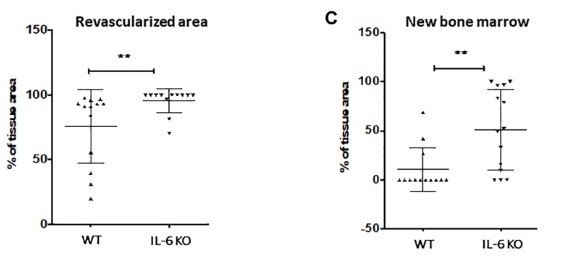Article Highlight: Kuroyanagi G, et al., Interleukin-6 deletion stimulates revascularization and new bone formation following ischemic osteonecrosis in a murine model. Bone. 2018 Aug 17. Pubmed: https://www.ncbi.nlm.nih.gov/pubmed/30125727
A recent publication by Kuroyanagi G et al demonstrated some interesting findings. In this study, a mouse model of osteonecrosis of the knee was used (induced damage to the blood supply of the knee, similar pathology to Perthes disease but in a different body part). One of the mouse groups was genetically modified such that the IL-6 gene was knocked out. IL-6 is an inflammatory substance normally secreted by certain immune cells. Hence, these knockout mice no longer are able to produce IL-6.
When comparing the response to osteonecrosis in mice that did not have IL-6 knockout versus those that did, the IL-6 knockout mice demonstrated improvements in several areas at 4 weeks since osteonecrosis was induced
- Increased blood vessel formation in the damaged bone
- Increased bone marrow recovery
- Increased bone formation
This finding suggests that inflammation in the knee in this mouse model may impair or slow down bone formation. The collapse and deformity of bone can occur in osteonecrosis and Perthes disease due to the resorption and deformation of weak bone that ensues after the initial injury to the blood supply. The rate of new bone formation may be important in preventing excess collapse or deformation of the affected bone during this time, and this article suggests inflammation may play a key role.

